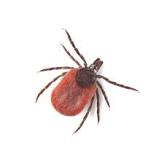Lyme Disease
P.K.Ghatak, M.D.
Lyme disease was unknown in the USA, but in 1970 an outbreak of a tick borne disease in Lyme, Connecticut established its name and proved to be the most common vector borne disease in the USA. About 30,000 cases of Lyme disease are reported each year. The bacterium belongs to the Spirochete family, and Lyme disease is due to Borrelia burgdorferi. The other important member of this family is syphilis.
Spirochetes are gram negative, spiral in shape, measuring 3 to 500 micrometers long and 0.03 to 3 micrometers in diameter and are motile due to the presence of variable numbers of flagella arranged along the axis
The vector is a tick – Ixodes scapularis, rarely another tick - Amblyomma americium (Lone star tick) transmit the spirochetes in the southern states.

The adult tick must feed 48–72 hours during that time, B. Burgdorferi enters the wound from the tick's saliva contamination.
The incubation varies from a few days to several weeks following the tick bite.
Based on the time of presentation and symptoms, the disease is conveniently separated into 3 groups.
Initial. Skin rash and slight fever. The skin rash is the hallmark of Lyme disease at this stage. The rash is red to violet in color, target like lesions called Erythema marginatum.
Early disseminated disease usually developed in 2 -3 weeks but may be late, as late as 10 weeks. The presenting symptoms are painful swelling of one knee or ankle, musculoskeletal pain, conjunctivitis, heart block, and Bell's palsy.
Late or chronic. After months of quiet period, the asymmetrical arthritis of hands and spine, headaches, peripheral neuropathy, muscle weakness, cranial nerve palsy develop and persist for a long time despite treatment.
The skin rashes are due to an inflammatory reaction from the presence of spirochetes in the skin. The spirochete may enter fibroblasts and live in them permanently. In the early state, 50% of patients are seropositive, it becomes 100 % as weeks and months progress. Arthritis develops from cross-reaction of the spirochetal membrane protein with the host's connective tissue and neural tissues. The newly formed complex is antigenic. The antibodies react with the complex, and organ damages take place from released pro-inflammatory cytokines. People having HLA-DR$ and HLA-DR2 are likely to suffer most.
Chronic neurological manifestations are the results from the presence of the remnant DNA of the spirochetes in the nervous system of the victims, which triggers an excess production of Interferon alpha.
CDC recommends the following procedures.
Initial stage: ELISA immunoassay of IgM and IgG.
Confirmatory stage: Western blot testing.
a). Symptomatic for less than 30 days. Perform both IgM and IgG Western blot tests.
b). Symptomatic for more than 30 days, only IgG Western blot test is advised.
c). A newer test - the C6 peptide test, which was prevalent in Europe, has been approved as an alternative to the Western blot test. C6 peptide test is less expensive and equally sensitive as the Western blot test.
Initial stage: The preferred antibiotic is Doxycycline by mouth for 10 to 21 days. Children, pregnant and lactating women should have Amoxicillin or Cefuroxime axetil PO for 10 to 21 days.
With cardiac, neurological or musculoskeletal involvement, the treatment should be continued for 28 days.
In late stage: Parenteral Ceftriaxone, or Cefuroxime or Penicillin G in high doses given for 14 to 28 days.
Post-treatment Lyme Disease:
About 20% of patients who completed recommended treatment continue to be moderately symptomatic for 6 months or longer. The common symptoms are fatigue, musculoskeletal pain, hearing loss, headaches, ambulatory and balance problems, paresthesias, depression and sleeping difficulties, and other symptoms.
************************************************************

No comments:
Post a Comment